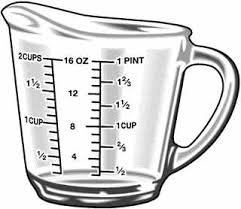Maths Summer 1
Maths Work
This half term in Maths we are learning about capacity, as this links well with our Rivers and Bridges topic. Capacity is another type of volume that measures liquids.
Think about it – do you know what unit of measurement is used
for capacity?
It’s litres (L) and millilitres (ml)!
There are 1000ml in 1L.
Therefore: ½ l = 500 ml
¼ l = 250 ml
¾ l = 750 ml
1/10 l = 100 ml
These are some facts that are worth learning and remembering as they will help you throughout school and later on in life.
Over the next couple of weeks, if you have a measuring jug at home measure the capacity of different items around you house, for example mugs, bowls and vases and practise reading the scale to measure this. Try the same outside in the nice weather!
If you do not have a measuring jug, have a look at some of the liquids and food items that you have at home and see if you can find a measurement (in ml or L) for them and display them in a table. This will help you with skills for estimating capacity.
Ask a parent to save you a used drinks bottle and use this to help measure capacity. For example if you have a 1L bottle can you find the approximate halfway point and mark this as 500ml? Can you do the same for ¼ and ¾? This way you could create your very own measuring jug!
We would also like you to complete a maths investigation to keep your brains working. Choose one of the following suggestions or choose your own from the NRich website (https://nrichs.maths.org)
Sparkle: Sort the Street https://nrich.maths.org/5157
Shine: Follow the numbers https://nrich.maths.org/7127
OR Birthday https://nrich.maths.org/13697
Glow: Pebbles https://nrich.maths.org/48
OR the attached twinkl odd and evens investigation.
We would also like you to keep practising your 4 operations (+ - x ÷)
Use a dice/ a parent or sibling/ alexa to generate 1, 2 or 3-digit numbers for you to add using whichever methods you have been taught in class. For most of you this is column method but some of you can use partitioning or drawing out deans. Do the same for subtraction (take away). Try at least 6 questions for each please.
Practise your times tables (and their division facts) on timestable rockstars! Finally have lots of fun with maths over the next few weeks.
